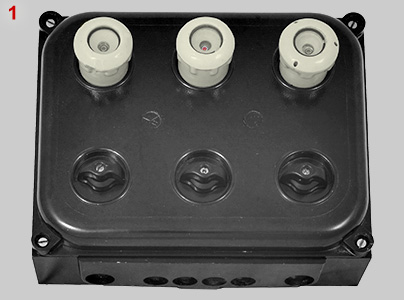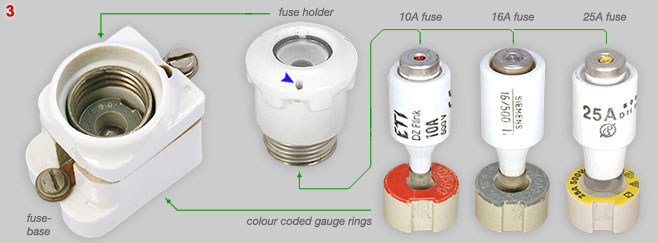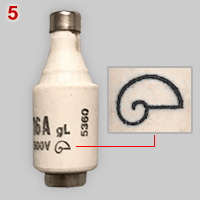 |
Classic
distribution board with D-type fuses |
site map |
(DDR) |
| Distribution boards are not a core part of
the museum collection. The reason to show an example is the fact
that the majority of homes in the
Netherlands are equipped with distribution boards made by
Hollandse Apparaten Fabriek (HAF, now part of ABB) or Hazemeyer Hengelo
(now Holec Eaton). The example shown below is a classic distribution board with D-type fuses. D stands for Diazed, which is an abbreviation of diametrisch abgestufter zweiteiliger Edison Schmeltzst÷psel (diametrically graded two-part Edison thread). Seven series of D-fuses exists. Examples of the most commonly used DII (= D-two) are shown on this page. Find examples of several more types (DDR made) on the next page. Find detailed information on the Wikipedia IEC 60269 page. Diazed fuses have been developed in 1906 by Siemens AG. They are used for more than half a century in Germany, Netherlands and several other continental European countries. Most D-type fuses are replaced by modern circuit breaker switches in combination with residual-current devices. However, diazed fuses are still available for replacement. |
 |
 |
 |
| 1, 2 |
Domestic
distribution board that divide incoming electricity into three groups.
Each group has a D-type (Diazed) fuse and a two-pole switch. The main
switch is located in separate box (not shown). Protective earth wires
of the three groups are connected to the main earth bar, located
elsewhere. The shown distribution board dates back to the 1960s. A
residual-current device was not incorporated. In Dutch homes they
became
compulsory in 1975. Manufacturer: Hollandse Apparaten Fabriek (HAF). Essentially identical distribution boards with D-type fuses have been made by Hazemeyer Hengelo (HH). See list of Dutch manufacturers for company details. {PO} |
| 3 | Components of a
steatite fuse holder and three diazed fuses. 10A and 16A were most
frequently used in homes. 20A and 25A fuses were mainly restricted to
workshops. In the 1920s-'30s also 6A fuses could be found in
homes. The diameter of the smaller end cap of a fuse varies with the fuse rating. Fuse gauge rings have a gap that corresponds to the cap diameter of a specific fuse. It is a safety measure that prevents replacing a blown fuse by a fuse with a higher rating. Gauge rings are colour coded; see image No. 4 for details. The larger end cap has a spring-loaded button. The colour of the button is the same as the matching gauge ring. The button is ejected when a fuse blows. Fuse holders have a glass window to enable inspection which fuse is blown. Fuse holders - for fuses up to 25A - have an Edison 27 mm screw thread. The holder shown in image 3 is an older model that has a hole (blue arrow), used to seal the cap. Until the 1950s - in the Netherlands - only electricians were authorized to replace a blown fuse, or change a gauge ring. |
| 4 | Diazed
plugs that fit in E27 fuse holders - the D II series - exist for the
following currents: 2A, 4A, 6A. 10A, 16A, 20A and 25A. Corresponding
colour coded gauge rings have gaps that match with the smaller end cap
of the fuse. Siemens engineers have decided to follow the colours of the German Germania postage stamps series, introduced in 1900. The image below shows the 5, 10, 15, 20 and 25 Pfennig stamps and the corresponding 6A, 10A, 16A (initially 15A), 20A and 25A rings. Sources: German Wikipedia page about Schmelzsicherung and English page Germania (stamp). |
 |
 Photo provided by Peter W. Martin |
5. Besides voltage and amperage rating diazed plugs may have additional markings. gL: Fuse type, commonly used for domestic wiring systems. gL type is outdated and replaced by similar gG type. G = general, L = Leitung (wire). Snake symbol: Fuse speed is the time it takes to blow a fuse when a fault current occurs. The snake-shell symbol indicates a slow acting fuse. "Flink", on the German 10A fuse (image no. 3), refers to a fast acting fuse. |
| |
D i g i t a l M u s e u m o f | |
P l u g s a n d S o c k e t s | |